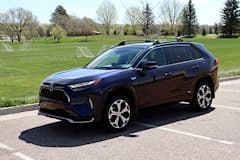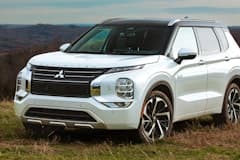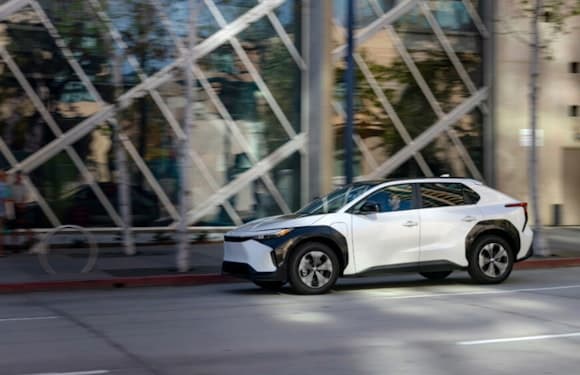
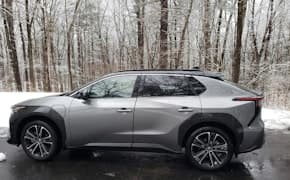
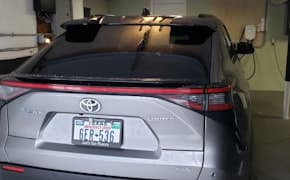

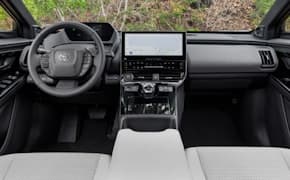
Show all photos
Summary
Toyota was the first automaker to offer a battery-electric crossover in America. It was also the second. The first two (low-volume) generations of the RAV4 EV were popular with owners and lessees, but Toyota learned that making an affordable battery-electric vehicle (BEV) profitable was unfeasible. Fast forward to today, and the bZ4X is Toyota’s third-generation BEV crossover. The bZ4X has a lot to offer some buyers, and it is impractical for others.
- Fun to drive
- Modern conveniences
- Great infotainment system
- Limited winter range
- Slower to charge in some scenarios than competitors
- No spare tire
- Dual-voltage charging cable now standard
- Improved range estimation display
Verdict - Is the 2024 Toyota bZ4X a Good Crossover?
The Toyota bZ4X is a five-passenger hatchback or crossover, depending on how you draw the line between such vehicles. It is roomy for both front and rear passengers and has a very deep and spacious cargo area. The infotainment system is outstanding. Both Android Auto and Apple CarPlay are wireless and worked flawlessly in our testing. There is a wireless phone holder/charger perfectly positioned in the center console and lots of other available power ports for guests.
The bZ4X is an AWD battery-electric vehicle (BEV), and that influences much of the personality of the vehicle. Look down the page for details on living electric. Our opinion is that the bZ4X would be an ideal second car in a loyal Toyota household.
Overall Car Talk Award
Car Talk researchers have tested this vehicle and decided to award it a 6 out of 10 based on our years of expertise and stringent criteria.
6/10
We have reviewed all of the following aspects of this vehicle.
3/10
7/10
8/10
Toyota bZ4X vs. The Competition
Pretty much the entire auto industry is now selling a BEV about the size of the bZ4X. Toyota’s version is more affordable than most, less impressive on paper than most, and very likely to prove more reliable than all. We chose a few vehicles we feel a shopper might consider when researching the purchase of a bZ4X.
Toyota bZ4X vs. Subaru Soltera
Toyota and Subaru have long worked very closely together. The two collaborate on the (fantastic) BRZ and GR86 and have often shared factory space for important mainstream models. The bZ4X and Soltera from Subaru are twins. If you have a Subaru dealer close to your home, we would cross-shop the two and look for the very best deal. They are identical in all meaningful ways.
Toyota bZ4X vs. Toyota RAV4 Prime Plug-in Hybrid-Electric Vehicle (PHEV)
One of our very favorite vehicles is the Toyota RAV4 Prime PHEV. The top trim bZ4X and RAV4 Prime are priced almost exactly the same. Since we feel practicality is paramount for many Toyota shoppers, the RAV4 Prime seems like a slam-dunk vehicle to cross-shop. With 40 miles of all-electric range, the RAV4 Prime is an EV for most owners for most trips. However, it can be a long-distance hybrid when a road trip beckons. Every U.S. Spec RAV4 Prime has a spare tire.
Toyota bZ4X vs. Hyundai Ioniq5 (SEL AWD)
The Hyundai Ioniq5 is a better electric vehicle than the bZ4X. More range, more power, faster charging. The SEL AWD trim is identically priced to the bZ4X Limited AWD at $52K. We like the Hyundai warranty better. It would be silly not to cross-shop these two. When we last tested the Ioniq5, the only things we remember missing were wireless Android Auto and Apple CarPlay.
How Much Does a Toyota bZ4X Cost?
The bZ4X is offered in two trims. The base XLE front-wheel drive bZ4X with no options in color starts at $44,420. We tested the top trim Limited AWD with a few important options at a 2024 price of $52,665. These prices include Delivery, Processing, and Handling but do not include dealer Doc fees, dealer vehicle prep fees, or added dealer content.
One problem for the bZ4X is that a RAV4 Prime plug-in hybrid is a better and more practical vehicle in nearly every way from our perspective and costs a bit less than a top-trim bZ4X. If the bZ4X were priced $10K lower at both trim levels, we would feel differently about the vehicle’s value and viability.
What's New for the Toyota bZ4X in 2024?
The bZ4X was introduced as a 2023 model-year vehicle and is a carry-over for 2024. Our tester was a 2023, but had all the same content as the 2024. For the new year, Toyota is including the dual-power mobile charger standard on all trims. That is important. Also, some other content became standard across the two trims.
Performance - How Does the Toyota bZ4X Drive?
The single best thing about the bZ4X is how it drives. Despite having a relatively low hp and torque rating (both around 200), the bZ4X is fun, quick, and sporty. We had a $62K five-passenger Lexus Hybrid the week before the bZ4X, and the bZ4X was hands-down more engaging and enjoyable to drive. The instant torque is addictive. When folks say, “Drive an EV, and you will never go back to a regular car again,” this is what they are talking about.
Steering, stopping, and ride comfort are all better than good in the bZ4X. In daily driving at (close to) legal speeds, the bZ4X can be really, really fun to push around. You have to be careful not to overdo things and risk a ticket. It’s that fun to drive. You don't sit up super high, and there is no comparison between the bZ4X and an SUV. The bZ4X handles like a car. Visibility is excellent.
The bZ4X has great ergonomics. The seats are comfy and sized for real people. The center console is generously sized and well laid out. We like the new Toyota binnacle behind and above the steering wheel. It offers a minimalist view of just what you need to know and negates the need for a head-up display. The phone tray and cup holders are perfect.
The interior does feel a little bit plasticky. Many of the secondary things you see and feel are hard and shiny. We would not even mention it if this car cost $40K, but at nearly $53K, it feels a little bit cheap.
If it snows, you will be pleased to know the wipers can lift up to prevent freezing and to make clearing snow easier. We spotted the Subaru X-Mode AWD dive button right away. Cool! It snowed or rained most of the days we tested the bZ4X, and it was very livable, other than the reduction in range.
Want some complaints? When you back up, it goes “beep beep beep.” That gets old fast. The infotainment system wants you to “load a profile.” Why? You can hear the rear wheels through the cabin. However, the cabin is super quiet, so that could be the reason we hear them. Last, why not fit tires with a severe-snow duty rating like Michelin CrossClimate2 or even Falken Aklimates so owners don’t have to buy winter rubber?
The bZ4X has a feeling of being built to a budget that we are not used to seeing and feeling in a Toyota. Maybe we are being overly critical, but this car costs almost $53K. It doesn't feel like a car that high in price, other than the excellent powertrain and premium audio.
Living Electric With the Toyota bZ4X - How Easy Is Charging and How’s the Range?
The 2024 bZ4X Limited AWD has an EPA-Estimated range of 222 miles. FWD trims have slightly higher estimated ranges. During our testing in New England in January, the bZ4X displayed a total range from 155 miles (28F) to 168 miles (38F) when fully charged. Cold weather and highway speeds dramatically reduce the total range “estimate” of the bZ4X. While this is not unusual for EVs, the bZ4X already has a range at the lower end of the market’s offerings.
During our testing, we did not run the bZ4X from 100% state of charge (SOC) to empty. Few vehicle testers do that since it requires being towed at the end of the range test. However, the range miles displayed dropped at the same rate as odometer miles, so we feel the range estimator was about right.
Charging the bZ4X using our Level 2 Emporia home charger was simple and easy. The front driver’s side charge port was ideally located for our nose-in-garage use and the bZ4X charges the same way as all the BEVs we test. The 72.8 kWh battery pack is on the low end of the average for a BEV of its size and price.
The bZ4X has a 7.6kW onboard charger (used when performing AC charging), so it can put to use an input rate of about 30 amps on a 240V circuit. More power from a stronger charger goes unused. The DC fast charge rate is 150 kW. This is much lower than the rating of vehicles from Kia and Hyundai, but most public DC fast chargers are not rated above 150kW in our area anyway, so this is not a real-world negative in our view. If you find a bank of open, available, and not broken DCFCs with a rating of 350kW, you will charge more slowly than some other similar vehicles might. In years of testing EVs, that scenario has almost never unfolded for us.
One thing we like about the bZ4X is that it comes standard with a dual-voltage mobile charger. So, all you need is a NEMA 14-50 outlet, and you could Level 2 charge the very same day you bring home your bZ4X. Or you could plug into a 115V wall outlet as a last resort and trickle-charge. We would strongly recommend to any BEV owner that they have a home wall-mounted Level 2 charger. Here is a list of some great Car Talk-tested home chargers priced under $400.
We drove the bZ4X every day for about 25 to 100 miles and would let its battery SOC drop to about 50% before putting the vehicle on our home charger. So we didn't need to charge it every day. During our week with the car, there was one trip we opted not to make with the bZ4X since its range was not enough to get us there and back without charging in public. Why risk the hassles and wasted time of public charging, not to mention range anxiety, when we have other vehicles available without those drawbacks? Others may feel differently about how to use a vehicle, but for us, and we suspect for many Toyota owners, convenience is paramount.
One last note. The bZ4X, like many BEV models on sale in 2024, is equipped with the old J-plug charging setup. That is going away. Adapters will be available, but America will soon be using the NACS (Tesla-style) charging plugs and sockets. Unless you must have a bZ4X right now, waiting a model year for the newer equipment to become fitted may make sense.
Safety - How Safe is the Toyota bZ4X?
IIHS has done limited testing of the new bZ4X. It has performed very well in all crash tests, but a poor rating of its base model headlights spoils any chance at awards. NHTSA rates the bZ4X five stars overall.
Reliability & Quality - Is the Toyota bZ4X Reliable?
All Toyota vehicles are reliable relative to their industry peers until proven otherwise. We checked out the Consumer Reports reliability score for the bZ4X and found it earned a 47/100. That sounds bad until you see that the Hyundai Ioniq5’s score is 33 and the VW ID.4’s score is 29! In the 2023 J.D. Power Dependability Study, the Toyota band lands in the top quadrant of automakers.
Features - What Toyota bZ4X Options Are Worth It?
From our perspective, there are two ways for a bZ4X shopper to go. Either get a bare-bones FWD XLE and bully your dealer into a deep discount or sweet lease deal, or go all the way, throw value to the wind, and get every option one can stuff into a Limited AWD. The JBL premium audio was an option on our Limited trim tester, and it was outstanding. Since we live in New England, we would definitely make sure our bZ4X had the Weather Package. It adds heated seats and a radiant heater for your legs.
Warranty - What is the Toyota bZ4X Warranty?
Toyota’s bZ4X warranty is enhanced by it being an EV. Toyota’s usual 36-month/36,000-mile basic new-vehicle warranty and 60-month/60,000-mile powertrain warranty are part of the package. However, the electric vehicle driving components, including the traction battery, are covered for 8 years or 100,000 miles, whichever comes first. If we were buying a new bZ4X, we’d bookmark our calendar for three months prior to the end of the EV-related warranty and plan to replace the vehicle.
Like every Toyota, the bZ4X comes with ToyotaCare covering normal factory-scheduled maintenance for two years or 25,000 miles, whichever comes first, and three years of roadside assistance, regardless of mileage.
Warranty overview:
- Basic: 3 years / 36k miles
- Powertrain: 5 years / 60k miles
- 2 years / 25,000 miles included maintenance
- Three years and unlimited miles roadside assistance
- If buying used, consider our list of best extended warranty providers
 Toyota BZ4X | |||
| Basic | - | 3 yr./ 36,000 mi. | - |
| Powertrain | - | 5 yr./ 60,000 mi. | - |
| Corrosion | - | 5 yr./ unlimited mi. | - |
New or Used - Is Toyota bZ4X Worth Buying Used?
There are no used bZ4X cars yet. It’s too soon. However, when they do start to show up, we would suggest limiting purchases to Certified Pre-owned ones until Toyota’s legendary reliability is proven for this all-new model.
